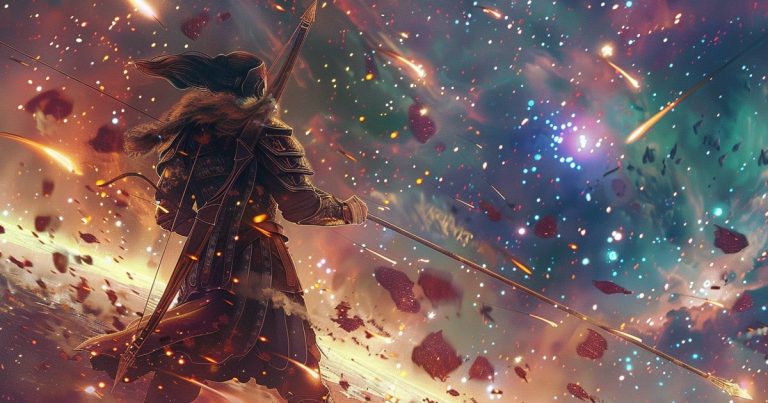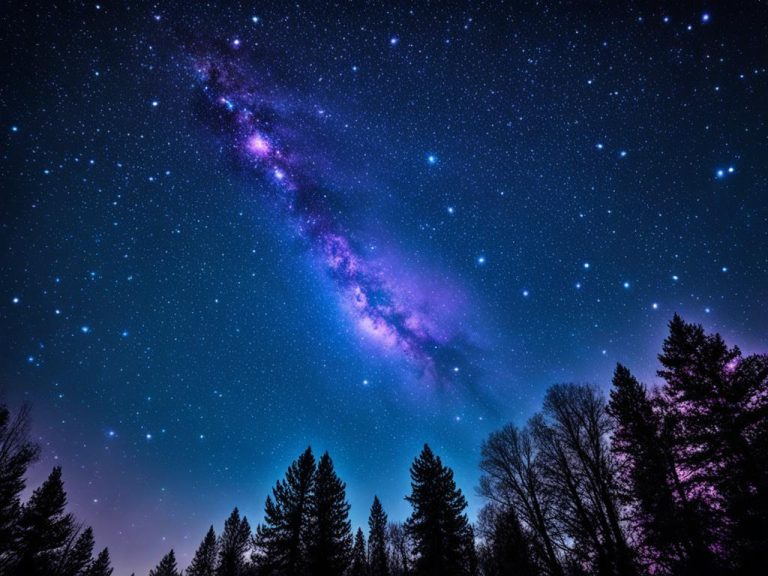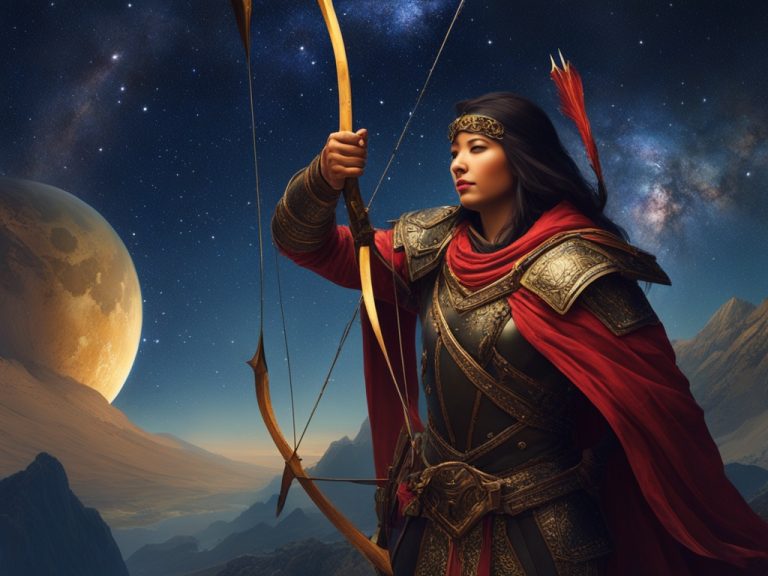Discover the Orion Constellation: The Hunter's Celestial Realm
Modified: Jun 29, 2024 Author: International Star Registry
Did you know the Orion constellation has two of the ten brightest stars? That’s right! Rigel and Betelgeuse light up the sky, fascinating everyone with their brightness.
Orion is known as the celestial hunter. It’s the 26th biggest constellation, covering 594 square degrees. This area is shared with constellations like Eridanus, Gemini, Lepus, Monoceros, and Taurus.
Rigel is the constellation’s brightest star, visible with an apparent magnitude of 0.18. It is the sixth brightest in the night sky. Betelgeuse falls closely behind with a magnitude of 0.43, making it the eighth brightest.
The constellation Orion is a beacon of many amazing stars perticularliy in the Orion Belt. It includes Alnitak, Alnilam, Bellatrix, plus three Messier objects: The Orion Nebula (Messier 42) and De Mairan’s Nebula (Messier 43).
Orion is special for its seven stars with planets and two meteor showers. The Orionids meteor shower is especially beautiful, happening around October 21 each year. It’s a great time to watch for falling stars.

Key Takeaways:
- Orion constellation contains two of the ten brightest stars in the sky – Orion stars Rigel and Betelgeuse.
- It is the 26th largest constellation, covering an area of 594 square degrees.
- Orion is bordered by neighboring constellations such as Eridanus, Gemini, Lepus, Monoceros, and Taurus.
- Rigel is the brightest star in Orion, while Betelgeuse is the second brightest.
- The constellation is home to stars with planetary systems and hosts two meteor showers – the Orionids and the Chi Orionids.
Are you ready to learn more about Orion? Let’s look into its history, myths, features, and its importance in the sky!
Learn more about the Orion constellation
Find additional information on Orion
History and Mythology of the Orion Constellation
The Orion constellation has a long history. It is filled with myths from cultures worldwide. In Greek tales, Orion is “The Hunter,” a key figure in the sky.
Orion’s story starts in ancient times, linked with the Sumerians. They called it URU AN-NA, or “light of heaven.” Since then, Orion has been easily seen by many. It has fascinated people over the years.
Greek myths have many stories about Orion. One tells of him chasing the Pleiades, a group of stars in Taurus.
Another story tells how Orion was born, thanks to Zeus, Neptune, and Hermes. It says Poseidon and Euryale are his parents. Armed with an unbreakable club, he was an unbeatable hunter.
Orion went on many adventures, slaying monsters with ease. He even went to the underworld with his dog, Sirius, to fight dark creatures.
Artemis, the hunting goddess, loved Orion. But her twin, Apollo, thought he could shoot better than her. Sadly, Artemis hit Orion by mistake. To honor him, she put him in the stars as the greatest hunter ever.
Orion’s stories are not just from Greece. Many cultures have myths about Orion. This includes Hungarian, Indian, Native American, and more.
If you want to know more about Orion, check out these resources:
- The Stories of the Stars: Orion the
- Woodland Ways: The Stories of the Stars – Orion the
- Wired: Meet the Constellations: Orion
Features and Location of Orion
The Orion constellation is famous as “The Hunter.” It stands out in the night sky with its vast 594 square degrees. You can see it from anywhere on Earth, making it very popular.
Looking up, you’ll notice Orion’s shape right away. It looks like a strong hunter with a club and shield. It’s found between +85° and -75° latitudes. Neighboring constellations include Eridanus, Gemini, and Taurus.
Orion: A Celestial Marvel
Orion is big and filled with incredible stars. We will talk about its bright nebulae and young stars later. This makes Orion a very special place in space.
Let’s now learn more about Orion’s secrets and marvels.
Notable Stars in Orion
Orion is a stunning constellation in the night sky. It boasts some of the brightest stars that we can see from Earth. Rigel and Betelgeuse are among the top ten for their brightness.
Rigel is a blue supergiant, ranking as the sixth brightest star. It shines brightly, making it a beautiful part of the night sky. Betelgeuse, a red supergiant, is the eighth brightest. It adds a warm, red glow to the stars around it.
Ten stars in Orion have their own names. These stars give Orion its unique appeal. Alnilam, Alnitak, Bellatrix, and Mintaka are some of the well-known stars in Orion.

Exploring the Brilliance of Rigel and Betelgeuse
Rigel shines because it’s so large and very hot. This makes it stand out in the night sky. Betelgeuse, however, shines in a way that it could become a supernova. It’s a star that attracts a lot of attention from scientists.
Looking up at Orion, we see Rigel, Betelgeuse, and other bright stars. Their beauty shows us the amazing things outside our planet.
Nebulae and Stellar Nurseries in Orion
The Orion constellation shines with beautiful nebulae and stellar nurseries. These parts of the sky let astronomers see how stars begin and light up the night.
The best-known nebula in Orion is the Orion Nebula (Messier 42). It’s in the Orion’s sword, a large area forming new stars. This is one of the brightest nebulae you can see without help, about 24 light-years across and 1,300 light-years from us. New stars are born there, brightening the area around them. The pinkish-red color comes from hydrogen gas.
De Mairan’s Nebula, or Messier 43, is not far from the Orion Nebula. Smaller and less bright, it’s still beautiful in its way.
The Horsehead Nebula is another extraordinary part. It’s inside the Orion Molecular Cloud Complex. This dark nebula looks like a horse’s head against a bright nebula. It has become famous among pictures of space.
In Orion, these nebulae are like baby rooms for stars. Huge clouds of gas and dust turn into places where new stars are born. By studying these areas, we learn a lot about how stars form and our galaxy’s life.
From the amazing Orion Nebula to the mysterious Horsehead Nebula, Orion’s parts keep us looking up. They show us how stars begin, teaching us about our universe’s beauty and size.
Astronomical Significance of Orion
The Orion constellation deeply interests people all around the globe. Stargazers are drawn to its features like Orion’s Belt, the Orion Nebula, and star clusters. This makes it loved by scientists and hobbyists alike.
Orion’s Belt is made up of three stars, Alnitak, Alnilam, and Mintaka. They shine brightly and help people spot other things in the sky. For those into taking photos of the stars, these stars are an important guide.
The Orion Nebula is a key part of the Orion constellation. It stays in the sword of Orion and is about 1,300 light-years from Earth. This beautiful place helps create new stars. The Trapezium Cluster in it is a group of four young stars. It gives scientists clues about how stars form and change.
Star clusters are also found in Orion. The Pleiades is one example and is close to Orion’s shoulder. These stars are hot, young, and perfect for pictures.
Orion means more than just pretty lights in the sky. It helps us learn about our universe. There seems to be a lot of planets around stars like the ones in Orion. And scientists believe there might be a black hole in the Orion Nebula. This black hole would be the closest one to Earth that we know of.
To learn more about the Orion constellation and its celestial wonders, you can visit the following resources:
- Discovering the Universe through the Constellation Orion
- Orion: The Hunter (EarthSky)
- Constellation Orion (Sea and Sky)
By studying the Orion constellation, we learn more about space. We find stunning parts of the universe to wonder at.
Naming a Star in Orion
Naming a star in the Orion constellation is a special way to celebrate. It’s perfect for a special day or to honor someone forever. With International Star Registry, you can name a star after someone and get a special star package. It’s a unique and lovely gift.
This service has been around since 1979. It lets you buy a star for someone as a gift that lasts through time. Your star comes with a certificate, map, and more. These items show the special bond between your loved one and their star in Orion.
For birthdays, anniversaries, or showing love, naming a star is perfect. It’s a memorable gift that stands out. It brings people together to talk about the vast universe.
By using International Star Registry (ISR), you know your dedication is real. ISR is well-known and trusted. It ensures your star’s name will always be kept and loved.
To find a unique and touching gift, try naming a star in Orion with International Star Registry. It’s a perfect way to mark any special moment. Honor someone dear, or just admire the night sky with this amazing present.
If you’re enchanted by the mystique of Orion and its celestial wonders, why not immortalize your connection with a personalized touch? Naming a star in the Orion constellation through International Star Registry allows you to leave a lasting mark in the night sky.
Whether you’re celebrating a birthday, Christmas, or anniversary, naming a star is a unique and meaningful gift that transcends time and distance. Imagine the delight on your loved one’s face as they gaze up at the heavens, knowing that a star bears their chosen name, forever twinkling in the vast expanse above.
At starregistry.com, you can easily browse through the stars in Orion and select the perfect one to dedicate to yourself or someone special. With just a few clicks, you can buy a star and receive a beautiful certificate commemorating your chosen celestial designation.

Orion in Mythologies Around the World
Orion is famous in Greek myth. But its story is known worldwide. People in many places have stories about this bright group of stars.
Now, let’s look at Egyptian mythology. Here, Orion is connected to a big god named Osiris. After Osiris came back to life, they said he went to live in Orion. This shows how special they thought Orion was.
Next up is Sumerian mythology. They see Orion as the great hero Gilgamesh. He fights a huge bull in their stories. Orion is the brave fighter highlighted in these tales.
Orion’s stories don’t stop in Egypt and Sumer. People in Arabia and ancient India also have their tales. This shows the universal love and respect for these stars.
Want to learn more about Orion’s myths? You can do it here.
Orion in Popular Culture
The Orion constellation’s beauty and myths have amazed people for ages. It shines in the night sky and appears in many tales and films.
Orion influences big movies. Beetlejuice uses it in the background to create a magical setting. In Stargate, Orion is key for space travel and adventure.
In books, Orion is just as important. In Middle Earth, Menelmacar stands for Orion, the Sky’s Swordsman. This shows Orion’s lasting impact on stories of fantasy and brave journeys.
Orion’s stories don’t stop with movies and books. They keep inspiring us. Its role in our cultural tales and nighttime sky stories proves its never-ending charm and fame.
The picture above shows Orion’s stunning view from here on Earth. Its unique form and bright stars fill us with wonder and creativity. This deepens Orion’s cultural and scientific value.
Conclusion
The Orion constellation is still a favorite for many. It shows many wonders in the night sky and has interesting stories. This makes it loved by both scientists and people who enjoy learning about myths.
Orion is known as a great hunter from ancient stories. By learning about Orion, we learn more about our universe. And we find joy in looking at the stars at night.
If you want a unique way to celebrate, consider naming a star in Orion. International Star Registry makes this possible. Giving a star is a special way to show your love, friendship, or to mark an important event.
Whether you’re looking at its stars or learning about its stories, Orion is always amazing. It’s a symbol of beauty and mystery that everyone can enjoy.
As we marvel at the beauty of Orion and its celestial companions, we are reminded of our timeless fascination with the cosmos. Whether through ancient mythology, scientific exploration, or personal connections, the stars above continue to inspire and captivate us.
So, take a moment to gaze upon Orion’s splendid form in the night sky, and consider the possibility of naming a star within its bounds. It’s not just a gift; it’s a celestial legacy—a testament to our enduring fascination with the wonders of the universe. Celebrities with stars named after them in Orion include Shirley McClaine, Michael Alexander Iglesias, Joey Kramer, Jake Johnson, Steve Irwin, and Andy Kaufman.
Visit starregistry.com to explore the stars of Orion and embark on your journey to name a star today.
FAQ
What is the Orion constellation?
The Orion constellation is a group of stars seen in the winter night sky. It’s known as the Celestial Hunter.
What is the mythology behind the Orion constellation?
In Greek myths, Orion was a mighty hunter. He’s shown in the stars chasing the Pleiades or facing the Bull, Taurus.
Where is the Orion constellation located?
Orion is one of the 15 constellations near the equator. You can see it between +85° and -75° latitude. It’s near Eridanus, Gemini, and other constellations.
What are the notable stars in the Orion constellation?
Orion has the bright stars Rigel and Betelgeuse. Also, there’s Alnilam, Alnitak, and others like Bellatrix.
Are there any notable nebulae in the Orion constellation?
The Orion Nebula is very famous. There are also the Horsehead Nebula and De Mairan’s Nebula.
What is the astronomical significance of the Orion constellation?
Orion is key for night sky photos and finding your way. Orion’s Belt helps navigate. The Trapezium Cluster is studied here too.
Can I name a star in the Orion constellation?
Yes, you can name a star here. International Star Registry lets you give a star name. It’s a special present.
How is Orion connected to different mythologies?
Orion is linked to Egypt’s Osiris and Sumer’s hero against the sky bull. Many cultures have tales about Orion.
Has Orion made appearances in popular culture?
Orion is in movies like Beetlejuice and Stargate. It’s also in J.R.R. Tolkien’s Middle Earth. Many stories feature Orion.
What makes the Orion constellation special?
Orion offers amazing views, old stories, and star naming chances. It’s great for any event. The stars make a wonderful gift.
Source Links
- Orion (constellation) – https://en.wikipedia.org/wiki/Orion_(constellation)
- Ori – Orion the Hunter – https://skytonight.org/ori
- Stars, Facts, Myth, Location – Constellation Guide – https://www.constellation-guide.com/constellation-list/orion-constellation/
